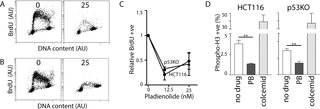PLOS ONE ( IF 3.7 ) Pub Date : 2018-01-16 , DOI: 10.1371/journal.pone.0191178 Erin J. Vanzyl , Kayleigh R. C. Rick , Alex B. Blackmore , Erin M. MacFarlane , Bruce C. McKay

|
The spliceosome is a large ribonucleoprotein complex that catalyzes the removal of introns from RNA polymerase II-transcribed RNAs. Spliceosome assembly occurs in a stepwise manner through specific intermediates referred to as pre-spliceosome complexes E, A, B, B* and C. It has been reported that small molecule inhibitors of the spliceosome that target the SF3B1 protein component of complex A lead to the accumulation of cells in the G1 and G2/M phases of the cell cycle. Here we performed a comprehensive flow cytometry analysis of the effects of isoginkgetin (IGG), a natural compound that interferes with spliceosome assembly at a later step, complex B formation. We found that IGG slowed cell cycle progression in multiple phases of the cell cycle (G1, S and G2) but not M phase. This pattern was somewhat similar to but distinguishable from changes associated with an SF3B1 inhibitor, pladienolide B (PB). Both drugs led to a significant decrease in nascent DNA synthesis in S phase, indicative of an S phase arrest. However, IGG led to a much more prominent S phase arrest than PB while PB exhibited a more pronounced G1 arrest that decreased the proportion of cells in S phase as well. We also found that both drugs led to a comparable decrease in the proportion of cells in M phase. This work indicates that spliceosome inhibitors affect multiple phases of the cell cycle and that some of these effects vary in an agent-specific manner despite the fact that they target splicing at similar stages of spliceosome assembly.
中文翻译:

流式细胞仪分析将S和M期的变化鉴定为剪接抑制剂isoginkgetin诱导的新细胞周期改变
剪接体是大的核糖核蛋白复合物,它催化从RNA聚合酶II转录的RNA中去除内含子。剪接体组装通过称为中间剪接体复合体E,A,B,B *和C的特定中间体以逐步方式发生。据报道,靶向复合体A的SF3B1蛋白成分的剪接体小分子抑制剂可导致在细胞周期的G 1和G 2 / M期细胞的积累。在这里,我们对异格格丁素(IGG)的作用进行了全面的流式细胞术分析,这是一种天然化合物,在以后的步骤中会干扰复合体的组装,即复杂的B形成。我们发现IGG在细胞周期的多个阶段(G 1,S和G2)但不是M相。该模式与SF3B1抑制剂普拉二烯内酯B(PB)相关的变化有些相似,但有区别。两种药物均导致S期新生DNA合成显着减少,表明S期停滞。但是,IGG导致S期阻滞比PB更为明显,而PB表现出更明显的G 1阻滞,这也降低了S期的细胞比例。我们还发现,两种药物均导致M期细胞比例的下降。这项工作表明剪接体抑制剂会影响细胞周期的多个阶段,尽管这些作用的目标是在剪接体组装的相似阶段进行剪接,但其中某些作用仍以试剂特异性方式变化。



























 京公网安备 11010802027423号
京公网安备 11010802027423号